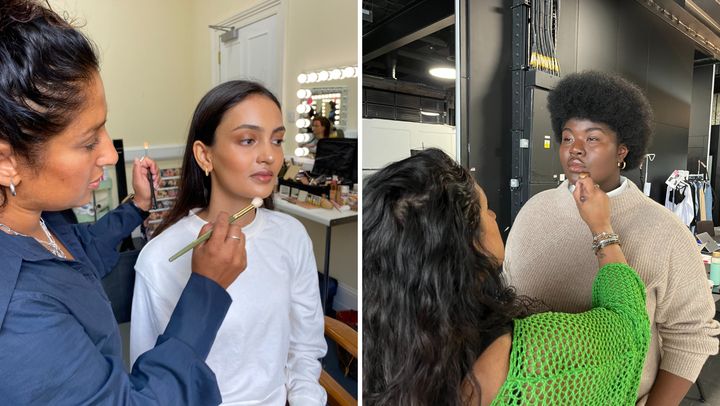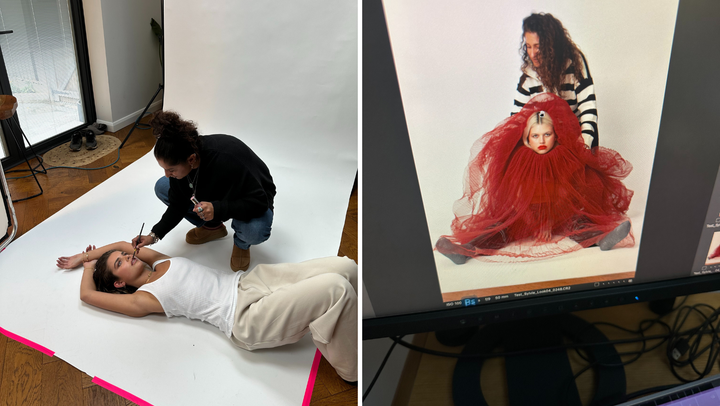
If you look at social media, the life of a makeup artist or hair stylist seems glamorous. But have you ever had any insight into how much money they actually make? The beauty industry is filled with freelance creatives who, more often than not, are not paid fairly ― which makes pay transparency more important than ever.
We spoke to Mira Parmar, a freelance international makeup artist, hair stylist and content creator based in London who revealed her fees and explained how she makes a living in the industry.
In addition to her freelance work, Parmar also creates content for her 23,600 followers on Instagram. She has more than 15 years of experience in the beauty industry, working with talents and publications including Suki Waterhouse, Cara Delevingne, Vogue, Elle and others.
The life of a freelance creative has its ups and downs, so income isn’t standard in a year. But Parmar shared that in an average year, she makes upward of $95,600. Here’s how it all adds up.

Parmar’s Rates For Various Work
Parmar doesn’t have an agent, so she has to set and negotiate all her fees by herself. The rates listed below refer to her work as a makeup artist, but because she’s also trained in styling hair, she offers her clients the option to add that to booked jobs. This is negotiated beforehand, and on average she adds $440 to the rate.
Parmar always charges a full day’s rate, even if the job lasts for a couple of hours. She does this because she won’t be able to book another client for the rest of the day, so she will essentially end up losing money if she agrees on a half-day rate, she explained.
Makeup For Editorial: $440-Plus
This fee is a day rate, which is either 8 a.m. to 6 p.m. or 10 a.m. to 2 p.m. Parmar will work on one or two models. “Sometimes editorial rates are lower or for free, which I think should be banned!” she said. “I like that some agencies are saying their artists will not be working for free from now on.”
Makeup For Red-Carpet Events: $440 To $1,200-Plus
Parmar explained that for the red carpets, the fee changes depending on which celebrity, actor or talent she is working with and for what brand. This is a set rate, and it’s usually a “glam and go,” she said. This means that after the makeup is done (which normally takes about 1 1/2 hours), she leaves. If there is an after-party following an awards ceremony, Parmar stays around to do the touch-ups, and she negotiates the rate beforehand.
Makeup For Weddings: $820 To $1,200-Plus
This fee is makeup for one person (the bride), and it varies. For example, if Parmar has to do a bridesmaid’s makeup as well, she will charge around $380 extra. If there are more bridesmaids needing to get their makeup done, Parmar will bring an assistant who is paid their own rate. Parmar usually leaves after the makeup is done, but if the wedding is within London, she might stay around for touch-ups. For destination weddings, Parmar charges the above plus accommodation and expenses for all travel days.
Teaching: $370 To $500
This is a day rate (10 a.m. to 4 p.m.) for teaching makeup application. Parmar works with a makeup school in London and often goes in to teach a small class of people. She explained that it’s a bit like a makeup master class, where she talks about products, the beauty industry, and how to get started as a makeup artist. She also does how-tos on specific techniques, like skin correcting or a trend-led technique like Pat McGrath’s base.
Makeup For Campaigns: $1,070-Plus
Brand campaigns include their lookbooks — everything you see on a website has usually been done in a studio with a full team. Here, Parmar charges a day rate, and she usually does makeup for one or two models. Sometimes the rate can include very minimal hair styling. Generally two makeup artists work on the campaign.
Makeup For Advertising: $1,200-Plus
Advertising here is usually what brands will put on billboards. For TV ads, the fee is higher since they take longer to film, more touch-ups are needed, and makeup needs differ between filming and still photography. This is a day rate, and it’s usually from 8 a.m. to 6 p.m. in a studio, working on one or two models.
Content Creation
In terms of her content creation, she has set rates but negotiates a bit. She is specific in which brands she works with, and ensures they’re always brands that she loves. “The prices vary depending on whether the brand is a startup or a big business,” she added.
Reels: From $1,070.
Stories: From $315.
Grid post: From $370.
How Fees Have Changed In The Beauty Industry In Recent Years
Since she started in 2008, the industry has changed a lot, Parmar said, with decreasing budgets and the implementation of artificial intelligence, both of which affect the jobs that a freelance creative books.
The COVID-19 pandemic was a huge blow to the work of freelance makeup artists, Parmar explained, as brands chose artists willing to work for free or for the “exposure,” which is often used to justify unpaid work.
“During and post-COVID-19, brands started using influencers to sell their products rather than booking makeup artists for campaigns, as it was better for them in terms of budgets, overheads, studio costs, lunches, studio equipment,” Parmar said.
Brands were focused on sales and their social media reach, which made Parmar feels like they didn’t even care if the influencers they hired for a campaign even liked their product. Compared with years ago, most brands can no longer afford international photoshoots and are trying to achieve the same results with a lower budget.
“Makeup artists are being asked to work for free when this job is a skill and should be paid. We all have to stick together in the industry, but sadly there will always be someone who will do the job for free, or for a low rate,” Parmar said.
“I’d like people to change the way they perceive creatives. We have to pay our bills and mortgages and keep ourselves afloat just like everyone else. Just because we are not in an office 9-6 doesn’t mean we are not working,” Parmar told HuffPost.